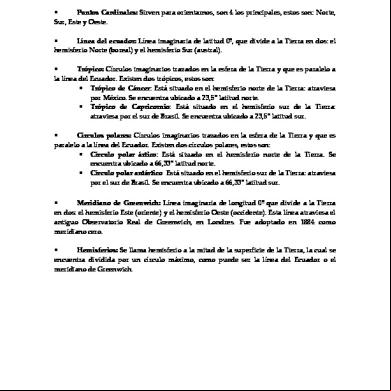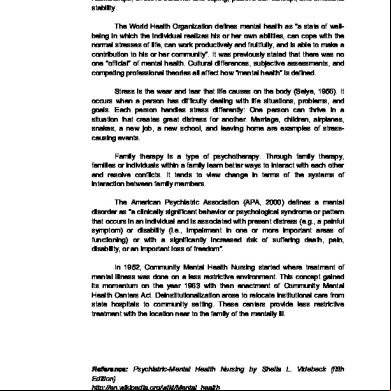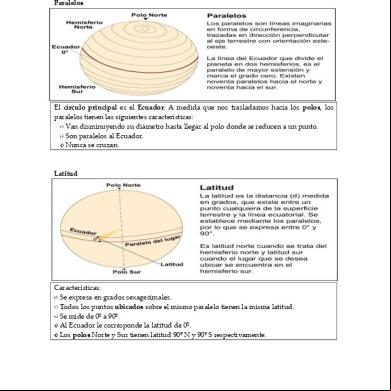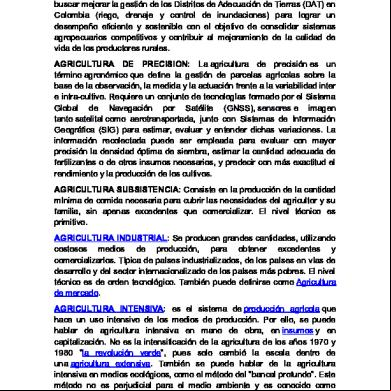Principles Of Marketing - Chapter 4 Handouts 1z151s
This document was ed by and they confirmed that they have the permission to share it. If you are author or own the copyright of this book, please report to us by using this report form. Report 3i3n4
Overview 26281t
& View Principles Of Marketing - Chapter 4 Handouts as PDF for free.
More details 6y5l6z
- Words: 1,446
- Pages: 7
12/11/2012
Learning Objectives i t ’s good and good for you
Topic Outline
Chapter Four Managing Marketing Information to Gain Customer Insights Copyright © 2012 Pearson Education
Chapter 4- slide 1
• • • • • •
Marketing Information and Customer Insights Assessing Marketing Information Needs Developing Marketing Information Marketing Research Analyzing and Using Marketing Information Other Marketing Information Considerations
Copyright © 2012 Pearson Education
Chapter 4- slide 2
Marketing Information and Customer Insights
Marketing Information and Customer Insights
Customer Insights are:
Customer Insights
• Fresh and deep insights into customers needs and wants • Difficult to obtain – Not obvious – Customer’s unsure of their behavior
• Better information and more effective use of existing information Copyright © 2012 Pearson Education
Chapter 4- slide 3
Marketing Information and Customer Insights
• Companies are forming customer insights teams – Include all company functional areas – Collect information from a wide variety of sources – Use insights to create more value for their customers
Copyright © 2012 Pearson Education
Chapter 4- slide 4
Marketing Information System
Marketing Information Systems (MIS)
Marketing information system(MIS) consists of people and procedures for: – – –
Assessing the information needs Developing needed information Helping decision makers use the information for customer
Copyright © 2012 Pearson Education
Chapter 4- slide 5
Copyright © 2012 Pearson Education
Chapter 4- slide 6
1
12/11/2012
Assessing Marketing Information Needs
Assessing Marketing Information Needs Characteristics of a Good MIS
MIS provides information to the company’s marketing and other managers and external partners such as suppliers, resellers, and marketing service agencies
• Balancing what the information s would like to have against what they need and what is feasible to offer ’s Needs
MIS Offerings Copyright © 2012 Pearson Education
Chapter 4- slide 7
Developing Marketing Information
Copyright © 2012 Pearson Education
Developing Marketing Information
Marketers obtain information from
Internal data Marketing intelligence Marketing research Copyright © 2012 Pearson Education
Chapter 4- slide 9
Chapter 4- slide 8
Internal Data
Internal databases are electronic collections of consumer and market information obtained from data sources within the company network Copyright © 2012 Pearson Education
Chapter 4- slide 10
Developing Marketing Information
Developing Marketing Information
Competitive Marketing Intelligence
Marketing Research
The systematic collection and analysis of publicly available information about consumers, competitors and developments in the marketplace
Copyright © 2012 Pearson Education
Chapter 4- slide 11
• Marketing research is the systematic design, collection, analysis, and reporting of data relevant to a specific marketing situation facing an organization Copyright © 2012 Pearson Education
Chapter 4- slide 12
2
12/11/2012
Developing Marketing Information
Developing Marketing Information
Steps in the Marketing Research Process
Marketing Research Defining the Problem and Research Objectives
Exploratory research Descriptive research Causal research Copyright © 2012 Pearson Education
Chapter 4- slide 13
Developing Marketing Information Marketing Research Developing the Research Plan
Copyright © 2012 Pearson Education
Chapter 4- slide 14
Developing Marketing Information Marketing Research Written Research Plan Includes: Management problem
• Outlines sources of existing data • Spells out the specific research approaches, methods, sampling plans, and instruments to gather data
Research objectives
Information needed How the results will help management decisions Budget
Copyright © 2012 Pearson Education
Chapter 4- slide 15
Developing Marketing Information
Copyright © 2012 Pearson Education
Chapter 4- slide 16
Developing Marketing Information Secondary Data
Marketing Research Developing the Research Plan
Advantages
Disadvantages
Secondary data consists of information that already exists somewhere, having been collected for another purpose
Cost
Current
Speed
Relevant
Could not get data otherwise
Accuracy Impartial
Copyright © 2012 Pearson Education
Chapter 4- slide 17
Copyright © 2012 Pearson Education
Chapter 4- slide 18
3
12/11/2012
Developing Marketing Information
Developing Marketing Information
Marketing Research Developing the Research Plan
Marketing Research Planning Primary Data Collection
Primary data consists of information gathered for the special research plan
Research approaches methods Sampling plan Research instruments
Copyright © 2012 Pearson Education
Chapter 4- slide 19
Copyright © 2012 Pearson Education
Chapter 4- slide 20
Developing Marketing Information
Developing Marketing Information
Market Research Research Approaches
Market Research Research Approaches
Survey research is the most widely used method and is best for descriptive information—knowledge, attitudes, preferences, and buying behavior
Observational research involves gathering primary data by observing relevant people, actions, and situations Ethnographic research involves sending trained observers to watch and interact with consumers in their natural environment Copyright © 2012 Pearson Education
Chapter 4- slide 21
• • • •
Flexible People can be unable or unwilling to answer Gives misleading or pleasing answers Privacy concerns
Copyright © 2012 Pearson Education
Chapter 4- slide 22
Developing Marketing Information Developing Marketing Information Market Research Research Approaches
Marketing Research Strengths and Weakness of Methods
Experimental research is best for gathering causal information—cause-and-effect relationships
Copyright © 2012 Pearson Education
Chapter 4- slide 23
Mail
Telephone
Personal
Online
Flexibility
Poor
Good
Excellent
Good
Quantity of data collected
Good
Fair
Excellent
Good
Control of interviewer effects
Excellent
Fair
Poor
Fair
Control of sample
Fair
Excellent
Good
Excellent
Speed of data collection
Poor
Excellent
Good
Excellent
Response rate
Poor
Poor
Good
Good
Cost
Good
Fair
Poor
Excellent
Copyright © 2012 Pearson Education
Chapter 4- slide 24
4
12/11/2012
Developing Marketing Information
Developing Marketing Information
Marketing Research Methods
Marketing Research Methods
• Focus Groups – Six to 10 people – Trained – Challenges • Expensive • Difficult to generalize from small group • Consumers not always open and honest
Copyright © 2012 Pearson Education
Chapter 4- slide 25
Developing Marketing Information Marketing Research Online Research
Internet surveys
Online s
Online experiments
Click-stream data
Online focus groups
Copyright © 2012 Pearson Education
Chapter 4- slide 26
Developing Marketing Information Marketing Research Sampling Plan
Advantages • Low cost • Speed • Higher response rates • Good for hard to reach groups Copyright © 2012 Pearson Education
Online marketing research
Chapter 4- slide 27
Sample is a segment of the population selected for marketing research to represent the population as a whole – Who is to be studied? – How many people should be studied? – How should the people be chosen? Copyright © 2012 Pearson Education
Chapter 4- slide 28
Developing Marketing Information
Developing Marketing Information
Marketing Research Sampling Plan – Types of Samples
Marketing Research Research Instruments
Probability Sample Simple random sample
Every member of the population has a known and equal chance of selection
Stratified random sample
The population is divided into mutually exclusive groups and random samples are drawn from each group
Cluster (area) sample
The population is divided into mutually exclusive groups and the researcher draws a sample
Nonprobability Sample Convenience sample
The research selects the easiest population
Judgment sample
The researcher uses their judgment to select population
Quota sample
The researcher finds and interviews a prescribed number of people in each of several categories
Copyright © 2012 Pearson Education
Chapter 4- slide 29
Questionnaires • Most common • istered in person, by phone, or online • Flexible • Research must be careful with wording and ordering of questions Copyright © 2012 Pearson Education
Chapter 4- slide 30
5
12/11/2012
Developing Marketing Information
Developing Marketing Information
Marketing Research Research Instruments—Questionnaires
Marketing Research Research Instruments
• Closed-end questions include all possible answers, and subjects make choices among them – Provide answers that are easier to interpret and tabulate
Checkout scanners
• Open-end questions allow respondents to answer in their own words
Mechanica l devices
– Useful in exploratory research Copyright © 2012 Pearson Education
Chapter 4- slide 31
Developing Marketing Information Marketing Research Implementing the Research Plan
Neuromarketing
People meters
Copyright © 2012 Pearson Education
Chapter 4- slide 32
Analyzing and Using Marketing Information Customer Relationship Management (CRM)
Managing detailed information about individual customers and carefully managing customer touch points to maximize customer loyalty.
Collecting the information Processing the information Analyzing the information Interpret findings Draw conclusions Report to management Copyright © 2012 Pearson Education
Chapter 4- slide 33
Analyzing and Using Marketing Information Customer Relationship Management Touchpoints
Customer purchases
Sales force s
Satisfaction surveys
Copyright © 2012 Pearson Education
Service and calls
Credit and payment interactions
Web site visits
Research studies
Chapter 4- slide 35
Copyright © 2012 Pearson Education
Chapter 4- slide 34
Distributing and Using Marketing Information Information distribution involves entering information into databases and making it available in a time-useable manner • Intranet provides information to employees and other stakeholders • Extranet provides information to key customers and suppliers
Copyright © 2012 Pearson Education
Chapter 4- slide 36
6
12/11/2012
Other Marketing Information Considerations Marketing Research in Small Businesses and Nonprofit Organizations International Market Research Public Policy and Ethics • Customer privacy • Misuse of research findings Copyright © 2012 Pearson Education
Chapter 4- slide 37
7
Learning Objectives i t ’s good and good for you
Topic Outline
Chapter Four Managing Marketing Information to Gain Customer Insights Copyright © 2012 Pearson Education
Chapter 4- slide 1
• • • • • •
Marketing Information and Customer Insights Assessing Marketing Information Needs Developing Marketing Information Marketing Research Analyzing and Using Marketing Information Other Marketing Information Considerations
Copyright © 2012 Pearson Education
Chapter 4- slide 2
Marketing Information and Customer Insights
Marketing Information and Customer Insights
Customer Insights are:
Customer Insights
• Fresh and deep insights into customers needs and wants • Difficult to obtain – Not obvious – Customer’s unsure of their behavior
• Better information and more effective use of existing information Copyright © 2012 Pearson Education
Chapter 4- slide 3
Marketing Information and Customer Insights
• Companies are forming customer insights teams – Include all company functional areas – Collect information from a wide variety of sources – Use insights to create more value for their customers
Copyright © 2012 Pearson Education
Chapter 4- slide 4
Marketing Information System
Marketing Information Systems (MIS)
Marketing information system(MIS) consists of people and procedures for: – – –
Assessing the information needs Developing needed information Helping decision makers use the information for customer
Copyright © 2012 Pearson Education
Chapter 4- slide 5
Copyright © 2012 Pearson Education
Chapter 4- slide 6
1
12/11/2012
Assessing Marketing Information Needs
Assessing Marketing Information Needs Characteristics of a Good MIS
MIS provides information to the company’s marketing and other managers and external partners such as suppliers, resellers, and marketing service agencies
• Balancing what the information s would like to have against what they need and what is feasible to offer ’s Needs
MIS Offerings Copyright © 2012 Pearson Education
Chapter 4- slide 7
Developing Marketing Information
Copyright © 2012 Pearson Education
Developing Marketing Information
Marketers obtain information from
Internal data Marketing intelligence Marketing research Copyright © 2012 Pearson Education
Chapter 4- slide 9
Chapter 4- slide 8
Internal Data
Internal databases are electronic collections of consumer and market information obtained from data sources within the company network Copyright © 2012 Pearson Education
Chapter 4- slide 10
Developing Marketing Information
Developing Marketing Information
Competitive Marketing Intelligence
Marketing Research
The systematic collection and analysis of publicly available information about consumers, competitors and developments in the marketplace
Copyright © 2012 Pearson Education
Chapter 4- slide 11
• Marketing research is the systematic design, collection, analysis, and reporting of data relevant to a specific marketing situation facing an organization Copyright © 2012 Pearson Education
Chapter 4- slide 12
2
12/11/2012
Developing Marketing Information
Developing Marketing Information
Steps in the Marketing Research Process
Marketing Research Defining the Problem and Research Objectives
Exploratory research Descriptive research Causal research Copyright © 2012 Pearson Education
Chapter 4- slide 13
Developing Marketing Information Marketing Research Developing the Research Plan
Copyright © 2012 Pearson Education
Chapter 4- slide 14
Developing Marketing Information Marketing Research Written Research Plan Includes: Management problem
• Outlines sources of existing data • Spells out the specific research approaches, methods, sampling plans, and instruments to gather data
Research objectives
Information needed How the results will help management decisions Budget
Copyright © 2012 Pearson Education
Chapter 4- slide 15
Developing Marketing Information
Copyright © 2012 Pearson Education
Chapter 4- slide 16
Developing Marketing Information Secondary Data
Marketing Research Developing the Research Plan
Advantages
Disadvantages
Secondary data consists of information that already exists somewhere, having been collected for another purpose
Cost
Current
Speed
Relevant
Could not get data otherwise
Accuracy Impartial
Copyright © 2012 Pearson Education
Chapter 4- slide 17
Copyright © 2012 Pearson Education
Chapter 4- slide 18
3
12/11/2012
Developing Marketing Information
Developing Marketing Information
Marketing Research Developing the Research Plan
Marketing Research Planning Primary Data Collection
Primary data consists of information gathered for the special research plan
Research approaches methods Sampling plan Research instruments
Copyright © 2012 Pearson Education
Chapter 4- slide 19
Copyright © 2012 Pearson Education
Chapter 4- slide 20
Developing Marketing Information
Developing Marketing Information
Market Research Research Approaches
Market Research Research Approaches
Survey research is the most widely used method and is best for descriptive information—knowledge, attitudes, preferences, and buying behavior
Observational research involves gathering primary data by observing relevant people, actions, and situations Ethnographic research involves sending trained observers to watch and interact with consumers in their natural environment Copyright © 2012 Pearson Education
Chapter 4- slide 21
• • • •
Flexible People can be unable or unwilling to answer Gives misleading or pleasing answers Privacy concerns
Copyright © 2012 Pearson Education
Chapter 4- slide 22
Developing Marketing Information Developing Marketing Information Market Research Research Approaches
Marketing Research Strengths and Weakness of Methods
Experimental research is best for gathering causal information—cause-and-effect relationships
Copyright © 2012 Pearson Education
Chapter 4- slide 23
Telephone
Personal
Online
Flexibility
Poor
Good
Excellent
Good
Quantity of data collected
Good
Fair
Excellent
Good
Control of interviewer effects
Excellent
Fair
Poor
Fair
Control of sample
Fair
Excellent
Good
Excellent
Speed of data collection
Poor
Excellent
Good
Excellent
Response rate
Poor
Poor
Good
Good
Cost
Good
Fair
Poor
Excellent
Copyright © 2012 Pearson Education
Chapter 4- slide 24
4
12/11/2012
Developing Marketing Information
Developing Marketing Information
Marketing Research Methods
Marketing Research Methods
• Focus Groups – Six to 10 people – Trained – Challenges • Expensive • Difficult to generalize from small group • Consumers not always open and honest
Copyright © 2012 Pearson Education
Chapter 4- slide 25
Developing Marketing Information Marketing Research Online Research
Internet surveys
Online s
Online experiments
Click-stream data
Online focus groups
Copyright © 2012 Pearson Education
Chapter 4- slide 26
Developing Marketing Information Marketing Research Sampling Plan
Advantages • Low cost • Speed • Higher response rates • Good for hard to reach groups Copyright © 2012 Pearson Education
Online marketing research
Chapter 4- slide 27
Sample is a segment of the population selected for marketing research to represent the population as a whole – Who is to be studied? – How many people should be studied? – How should the people be chosen? Copyright © 2012 Pearson Education
Chapter 4- slide 28
Developing Marketing Information
Developing Marketing Information
Marketing Research Sampling Plan – Types of Samples
Marketing Research Research Instruments
Probability Sample Simple random sample
Every member of the population has a known and equal chance of selection
Stratified random sample
The population is divided into mutually exclusive groups and random samples are drawn from each group
Cluster (area) sample
The population is divided into mutually exclusive groups and the researcher draws a sample
Nonprobability Sample Convenience sample
The research selects the easiest population
Judgment sample
The researcher uses their judgment to select population
Quota sample
The researcher finds and interviews a prescribed number of people in each of several categories
Copyright © 2012 Pearson Education
Chapter 4- slide 29
Questionnaires • Most common • istered in person, by phone, or online • Flexible • Research must be careful with wording and ordering of questions Copyright © 2012 Pearson Education
Chapter 4- slide 30
5
12/11/2012
Developing Marketing Information
Developing Marketing Information
Marketing Research Research Instruments—Questionnaires
Marketing Research Research Instruments
• Closed-end questions include all possible answers, and subjects make choices among them – Provide answers that are easier to interpret and tabulate
Checkout scanners
• Open-end questions allow respondents to answer in their own words
Mechanica l devices
– Useful in exploratory research Copyright © 2012 Pearson Education
Chapter 4- slide 31
Developing Marketing Information Marketing Research Implementing the Research Plan
Neuromarketing
People meters
Copyright © 2012 Pearson Education
Chapter 4- slide 32
Analyzing and Using Marketing Information Customer Relationship Management (CRM)
Managing detailed information about individual customers and carefully managing customer touch points to maximize customer loyalty.
Collecting the information Processing the information Analyzing the information Interpret findings Draw conclusions Report to management Copyright © 2012 Pearson Education
Chapter 4- slide 33
Analyzing and Using Marketing Information Customer Relationship Management Touchpoints
Customer purchases
Sales force s
Satisfaction surveys
Copyright © 2012 Pearson Education
Service and calls
Credit and payment interactions
Web site visits
Research studies
Chapter 4- slide 35
Copyright © 2012 Pearson Education
Chapter 4- slide 34
Distributing and Using Marketing Information Information distribution involves entering information into databases and making it available in a time-useable manner • Intranet provides information to employees and other stakeholders • Extranet provides information to key customers and suppliers
Copyright © 2012 Pearson Education
Chapter 4- slide 36
6
12/11/2012
Other Marketing Information Considerations Marketing Research in Small Businesses and Nonprofit Organizations International Market Research Public Policy and Ethics • Customer privacy • Misuse of research findings Copyright © 2012 Pearson Education
Chapter 4- slide 37
7










